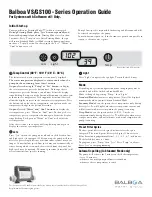
www.dimplex.de 452166.66.01 · FD 9506
EN-9
English
LA 22TBS - LA 28TBS
8 Cleaning / maintenance
8.1 Maintenance
To protect the paintwork, avoid leaning anything against the de-
vice or putting objects on the device. External heat pump parts
can be wiped with a damp cloth and commercially available do-
mestic cleaner.
NOTE
Never use cleaning agents containing sand, soda, acid or chloride, as
these can damage the surfaces.
To prevent faults due to sediment in the heat exchanger of the
heat pump, ensure that the heat exchanger in the heating system
can not be contaminated. Should operating malfunctions due to
contamination still occur, however, the system should be cleaned
as described below.
8.2 Cleaning the heating system
The ingress of oxygen into the heating water circuit may result in
the formation of oxidation products (rust), particularly if steel
components are used. These enter the heating system via the
valves, the circulating pumps and/or plastic pipes. A diffusion-re-
sistant installation is therefore essential, especially with regard to
the piping of underfloor heating systems.
NOTE
We recommend the installation of a suitable corrosion protection system
to prevent the formation of deposits (e.g. rust) in the condenser of the
heat pump.
Residue from lubricants and sealants may also contaminate the
heating water.
In the event of severe contamination leading to a reduction in the
performance of the liquefier in the heat pump, the system must
be cleaned by a heating technician.
Based on current information, we recommend using a 5% phos-
phoric acid solution for cleaning purposes. However, if cleaning
needs to be performed more frequently, a 5% formic acid solu-
tion should be used.
In both cases, the cleaning fluid should be at room temperature.
We recommend flushing the heat exchanger in the direction op-
posite to the normal flow direction.
To prevent acidic cleaning agents from entering the heating sys-
tem circuit, we recommend connecting the flushing device di-
rectly to the flow and return of the liquefier of the heat pump.
It is then important that the system be thoroughly flushed using
appropriate neutralising agents to prevent any damage from
being caused by cleaning agent residue remaining in the system.
Acids must be used with care and the regulations of the employ-
ers liability insurance associations must be adhered to.
The instructions of the cleaning agent manufacturer must always
be observed.
8.3 Cleaning the air system
The evaporator, fan and condensate drain should be cleaned of
contamination (leaves, twigs, etc.) before each new heating pe-
riod. The top covering panels of the heat pump see cap. 4 on
pag. 5 must be removed for this. The bottom left covering panel
may also have to be removed for cleaning the condensate drain
or the condensate pipe.
ATTENTION!
Before opening the device, ensure that all electric circuits are
disconnected from the power supply.
Remove and re-hang the side panel assemblies as described in
chapter 4.
To prevent the evaporator and the condensate tray from being
damaged, do not use hard or sharp objects when cleaning.
Under extreme weather conditions (e.g. snow drifts), ice may
form on the air intake and air outlet grids. If this happens, the ice
must be removed from the vicinity of the air intake and air outlet
grids to ensure that the minimum air flow is maintained.
8.4 Maintenance
Refrigeration circuits with a minimum refrigerant fill quantity of
3 kg, or "hermetically sealed" refrigeration circuits with at least
6 kg, must be tested for leaks yearly by the operator according to
regulation (EC) No. 842/2006.
The leakage tightness test is to be documented and archived for
a minimum of 5 years. The test is to be carried out by certified
personnel only, according to regulation (EC) No. 1516/2007. The
table enclosed in the attachment can be used as a basis for the
documentation.
NOTE
Local regulations may differ from EU directive 842/2006. The appropriate
local regulations for heat pump leakage tightness test must be observed.
9 Faults / troubleshooting
This heat pump is a quality product and is designed for trouble-
free operation. Should a fault occur, however, it will be indicated
on the heat pump manager display. In this case, consult the
"Faults and troubleshooting" page in the operating instructions of
the heat pump manager. If you cannot correct the fault yourself,
please contact your after-sales service technician.
ATTENTION!
Work on the heat pump must only be performed by authorised and
qualified after-sales service technicians!
10 Decommissioning /
disposal
Before removing the heat pump, disconnect it from the power
source and close all valves. The heat pump must be dismantled
by trained personnel. Observe all environmental requirements
regarding the recovery, recycling and disposal of materials and
components in accordance with all applicable standards. Partic-
ular attention should be paid to the proper disposal of refrigerants
and refrigerant oils.
















































